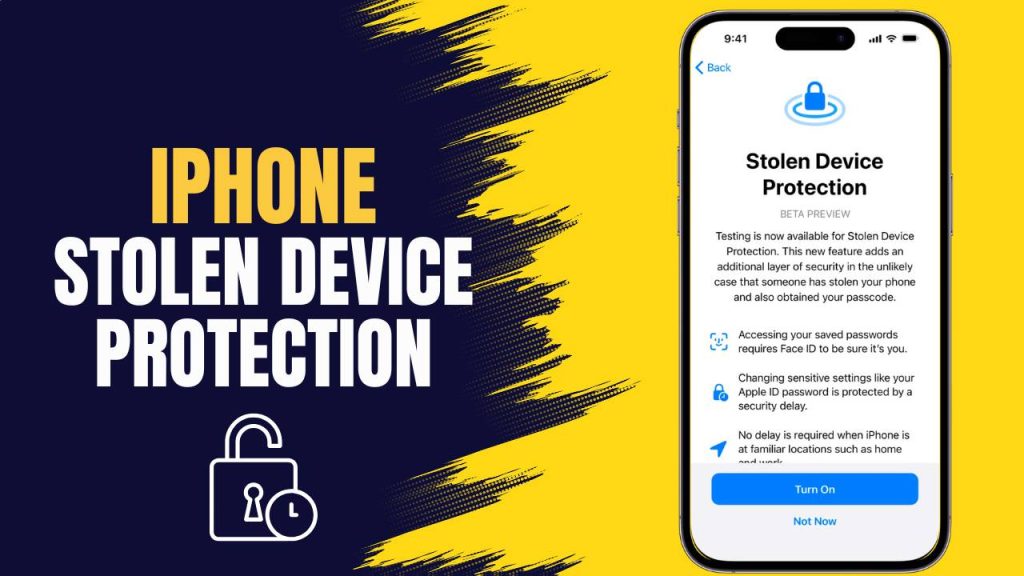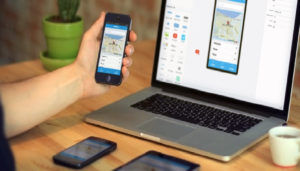iPhone is not just an essential communication device; it also stores a wide range of personal and professional data. From photos and videos to sensitive emails, banking apps, and passwords, your iPhone holds much more than just contacts and calls. Losing it to theft can cause significant inconvenience and pose serious security risks.
Understanding and implementing iPhone stolen device protection is important to securing both your device and personal data. Here are the necessary steps to safeguard your phone and its information, ensuring you’re prepared in case of theft.
Why iPhone Stolen Device Protection Matters
Every year, millions of iPhones are reported lost or stolen. Apple has made substantial improvements to security features, but it is up to the user to make the most of these protections. With sensitive personal information on your device, a stolen iPhone can lead to unauthorized access to your accounts, identity theft, and financial loss. This makes it even more important to use iPhone stolen device protection measures to prevent unauthorized access.
Why Are My iPhone Apps Crashing and How to Fix Them
11 Steps to Follow for iPhone Stolen Device Protection
Protecting your iPhone from theft is essential to safeguarding both your device and personal data. Follow these 11 essential steps, from enabling Find My iPhone to securing your accounts and data, to ensure you’re fully prepared in case of theft. Stay one step ahead with proactive measures and expert tips to keep your iPhone safe.
1. Enable Find My iPhone: Your First Line of Defense
One of the most important and effective tools Apple offers for stolen device protection is Find My iPhone. This service allows you to track your device, lock it remotely, and even erase its data if necessary. Here’s how to set it up:
- Turning on Find My iPhone: To activate Find My iPhone, go to Settings > [Your Name] > iCloud > Find My iPhone and toggle the feature ON. This will allow you to track your iPhone through the Find My app on another Apple device or via iCloud.com/find from any computer.
- Tracking Your Phone: If your iPhone is stolen, open Find My or visit iCloud.com/find to see the location of your device on a map. You can also use the feature to play a sound to help you locate it if it’s nearby.
- Lost Mode: If you are unable to find your phone, enabling Lost Mode locks the device with a passcode and displays a message on the screen (like your contact information), increasing the chances of someone returning it.
- Remote Data Erasure: In the worst-case scenario, you can remotely erase all data on your iPhone, ensuring no one can access your personal information. This action is irreversible, so it’s only recommended if you’re certain the phone cannot be recovered.
2. Use Strong Authentication Methods
Strong authentication methods go beyond just enabling Find My iPhone; they provide a critical layer of security to ensure your device remains protected. Without proper authentication, anyone who gains access to your device could potentially view or steal your personal data. By setting up a secure passcode and enabling biometric authentication, you create a solid line of defense against unauthorized access.
Set a Strong Passcode
Always opt for a six-digit passcode or an alphanumeric password. These options are much more difficult to crack compared to a simple four-digit PIN. It’s important not to use easily guessable codes like your birthdate or phone number. A strong passcode creates a barrier for anyone attempting to access your device and increases your security significantly. To set or change your passcode, go to Settings > Face ID & Passcode or Touch ID & Passcode.
Enable Face ID or Touch ID
Face ID and Touch ID are Apple’s biometric authentication methods that add an additional layer of security. These systems use your face or fingerprints to unlock your phone, making it incredibly hard for anyone else to access your device, even if they know your passcode. Setting up Face ID or Touch ID is simple and ensures that only you can unlock your device, adding peace of mind in case your phone gets lost or stolen. To enable this feature, navigate to Settings > Face ID & Passcode or Touch ID & Passcode.
3. Activate Two-Factor Authentication (2FA)
Enabling Two-Factor Authentication (2FA) significantly enhances your Apple ID and iCloud account security. 2FA requires more than just your password to log into your account. Even if someone gains access to your password, they won’t be able to use your Apple services without a secondary code sent to your trusted devices or phone number. This adds an extra layer of defense against unauthorized access.
Enable 2FA for iCloud
To activate 2FA for your iCloud, go to Settings > [Your Name] > Password & Security, then switch on Two-Factor Authentication. This ensures that your Apple services, including emails, photos, and notes, remain secure. With 2FA enabled, even if someone obtains your Apple ID password, they will need the verification code sent to your trusted devices to access your data.
Use 2FA for Third-Party Accounts
It’s not just about Apple services. To ensure that your financial data, social media, and other important accounts are secure, enable 2FA for apps like your bank, email accounts, and any other services that store sensitive information. This provides an additional layer of protection by ensuring that even if someone compromises your password, they cannot gain full access to your accounts without the second verification code.
4. Keep Your Data Backed Up Regularly
Backing up your iPhone regularly is the best way to ensure you don’t lose valuable information if your device is stolen. Both iCloud and iTunes (or Finder for Mac users) offer seamless options for backing up your data. Having a recent backup ensures that you can restore all your important files, apps, and settings to a new device, reducing the risk of losing everything in the event of theft.
iCloud Backup
Enable iCloud Backup by going to Settings > [Your Name] > iCloud > iCloud Backup. With this option, your phone will automatically back up every night when it is connected to Wi-Fi and charging, ensuring that your photos, contacts, apps, and other important data are regularly backed up without manual intervention.
Manual Backup via iTunes or Finder
Who prefer a more hands-on approach or want an offline backup, you can use iTunes (for older versions of macOS and Windows) or Finder (for macOS Catalina and later) to manually back up your iPhone to your computer. This provides a local backup, which you can restore in case of theft or data loss. This method gives you an additional option for securing your data.
5. Secure iCloud and Other Accounts
In addition to physical security, ensuring your iCloud and other online accounts are secure is just as important. Thieves often target these accounts to steal personal information, photos, or even gain access to banking details if apps like Apple Pay are linked. If your iPhone is stolen, changing your passwords and signing out of iCloud remotely are essential actions to take immediately.
Change iCloud Password Immediately
One of the first things you should do after your iPhone is stolen is to change your Apple ID password. This will block anyone from accessing your iCloud, Apple Music, Apple Pay, and other services linked to your account. Go to Settings > [Your Name] > Password & Security to change your password immediately.
Sign Out of iCloud Remotely
Through Find My iPhone on iCloud.com, you can remotely sign out of iCloud on the stolen device. This step is vital because it locks your account and prevents access to your photos, documents, emails, and other files stored in the cloud. It also ensures your personal data stays safe and reduces the risk of further misuse.
6. Take Preventive Measures to Avoid Theft
While securing your device with settings is essential, taking steps to avoid theft in the first place is just as important. Many thefts happen due to simple carelessness or poor judgment. Practicing vigilance and adopting preventive measures can help minimize the chances of theft.
Keep Your iPhone in a Safe Place
Always keep your iPhone in a secure place, whether at home or when you’re out in public. Avoid leaving it unattended in restaurants, coffee shops, or on public transportation. If you need to step away from the table or counter, take your device with you, or lock it in a secure place like a bag or drawer.
Use a Phone Case with a Strap
Using a phone case with a wrist strap is a simple yet effective way to deter thieves. Not only does it offer protection against accidental drops, but it also makes it harder for someone to quickly snatch your device. Additionally, many phone cases are designed with enhanced security features, such as anti-theft designs, making it more difficult for thieves to target you.
Don’t Show Your Phone Publicly
Avoid flashing your phone in public areas, especially when you’re not actively using it. The less visible your phone is, the less likely it is to attract unwanted attention from thieves. This is especially important in crowded areas or high-risk zones like public transport or busy streets.
iPhone Bluetooth Not Connecting to Devices? Try These Quick Solutions
7. Be Aware of Scams and Phishing Attempts
Once your iPhone is stolen, scammers may try to exploit the situation by attempting phishing attacks or identity theft. They might use your stolen phone or personal information to gain access to your accounts or trick your friends and family into sharing sensitive information.
Avoid Phishing Scams
After your phone is stolen, stay alert to phishing scams. Thieves may use your email or social media accounts to contact people on your behalf, trying to trick them into revealing personal or financial information. Always verify any suspicious communication and avoid clicking on unfamiliar links.
Sign Out of iMessage and FaceTime Remotely
Using Find My iPhone, you can remotely sign out of iMessage and FaceTime on the stolen device, preventing the thief from impersonating you and contacting your friends or family using your accounts. This is an important step to safeguard your privacy.
8. Report the Theft and Work with Authorities
If your iPhone is stolen, take immediate action to report the incident. Reporting the theft increases the chances of recovering your device, as authorities may be able to track or lock it.
Contact Apple Support
Inform Apple Support as soon as your iPhone is stolen. They may help you track the device, disable it, or provide further steps to protect your information.
Report to Your Carrier
Notify your carrier immediately to suspend your service and block the phone from being used on their network. Some carriers also offer theft protection services, which can further protect you from misuse of the device.
File a Police Report
In some cases, it may be necessary to file a police report, especially if you’re planning to make an insurance claim. A police report can provide official documentation of the theft, which can help recover your device and protect your data.
9. Use Third-Party Apps for Additional Security
While Apple offers excellent built-in security features, third-party apps can provide an additional layer of protection and give you more control over your device’s security.
Secure Your Messages
Apps like Signal and WhatsApp offer end-to-end encryption for your messages, ensuring that only you and the recipient can read them. This adds an additional layer of privacy and security for your communications.
Install Anti-Theft Apps
Apps like Prey Anti Theft or Cerberus can help you track and control your device remotely if it’s stolen. These apps offer features like remote tracking, alarm triggers, and data wipe capabilities, helping you safeguard your personal data even if your phone is lost or stolen.
10. Use Device Insurance or Theft Protection Plans
In addition to securing your device digitally, consider enrolling in a device insurance or theft protection plan. These plans can offer financial compensation or even replace your stolen device, making it easier to recover from the loss.
AppleCare+ for Theft and Loss
AppleCare+ with Theft and Loss provides coverage if your iPhone is lost or stolen. This plan allows you to replace your stolen device at a reduced cost, provided you have Find My iPhone activated and follow the necessary steps to report the theft.
Carrier Insurance Plans
Many mobile carriers also offer insurance plans that cover theft and loss. Check with your carrier to see if they offer protection for theft and loss and inquire about the terms and benefits.
11. Monitor Your Financial Accounts and Data
If your iPhone holds banking apps or payment systems like Apple Pay, it’s important to monitor your financial accounts after a theft to prevent unauthorized transactions.
Monitor Bank and Credit Accounts
Immediately check your bank statements and credit card accounts for any unauthorized purchases or suspicious activity. Report any suspicious transactions to your bank or credit card provider without delay.
Freeze Your Credit
As an additional precaution, you can freeze your credit with the major credit bureaus (Equifax, TransUnion, and Experian). This prevents identity thieves from opening new accounts in your name and gives you a safeguard against further misuse of your personal information.
iOS 17 Bugs and Glitches: What’s Affecting iPhone Users and How to Fix It
FAQs
1. What should I do immediately if my iPhone is stolen?
First, enable Find My iPhone via iCloud.com or the Find My app to track, lock, or erase your device. Immediately report the theft to your carrier, and change your Apple ID password to secure your account. Additionally, contact Apple Support and file a police report.
2. Can I track my stolen iPhone?
Yes, if Find My iPhone was enabled before the theft, you can track the device’s location via iCloud.com or the Find My app. You can also lock the device remotely or erase its data to protect your information.
3. How can I lock my stolen iPhone remotely?
Go to Find My iPhone on iCloud.com or use the Find My app to enable Lost Mode. This locks your device with a passcode and displays a custom message with a contact number on the screen, so someone who finds the phone can reach you.
4. Should I erase all data on my stolen iPhone?
If you believe your iPhone won’t be recovered, it’s a good idea to remotely erase all data through Find My iPhone. This ensures your personal data is deleted and cannot be accessed. If there’s still a chance of recovery, locking the phone first might be a better option to track it.
5. Can someone unlock my iPhone if it’s stolen?
If you’ve set a strong passcode or enabled Face ID or Touch ID, it’s highly unlikely that someone will be able to unlock your iPhone. Apple’s iOS security is designed to prevent unauthorized access. If your device isn’t secured, thieves may gain access to your data.
6. How do I report my stolen iPhone to my carrier?
Contact your mobile carrier immediately to report the theft. They can block your device from being used on their network, preventing unauthorized calls and data usage. Some carriers may also help you suspend service temporarily and provide assistance in tracking or securing your phone.
7. Can I get my stolen iPhone replaced by Apple?
If you have AppleCare+ with Theft and Loss coverage, you may be eligible for a replacement device for a reduced fee. Contact Apple Support to initiate the replacement process. Ensure that Find My iPhone is enabled to qualify for this coverage.
8. What if my iPhone is used for fraudulent activities after it’s stolen?
If you suspect that your stolen iPhone is being used for fraudulent activities, such as unauthorized purchases or identity theft, immediately report the incident to your bank and credit card companies. Also, freeze your credit with major credit bureaus to prevent further misuse of your personal information.
9. How can I secure my Apple ID after my iPhone is stolen?
Change your Apple ID password as soon as possible to prevent the thief from accessing your iCloud and other Apple services. You can do this via the Settings app on another Apple device or through the Apple ID website. It’s also recommended to enable Two-Factor Authentication for additional security.
10. Can I use a third-party app for additional protection?
Yes, third-party apps like Prey Anti-Theft or Cerberus offer additional security features like remote tracking, locking, and wiping your device, making them a great complement to Apple’s built-in security tools. These apps may also allow you to take pictures or track the device’s location if it’s being used by a thief.




